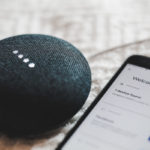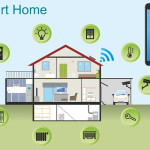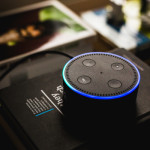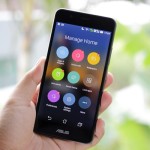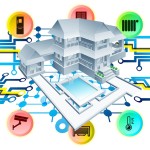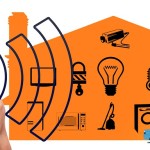Smart Homes 2019: What To Expect
We have seen smart technology take over many aspects of our lives. From smart phones to smart watches, smart technology continues to improve our day to day living and is spreading to our homes. A smart home incorporates smart technology into your house for added convenience and security among other benefits. Find out how you can start turning your house into a smart home this year.
Lighting
This is the most common way that people ease into smart home technology. Smart lighting allows you to set a timer for your lights and control them through an app or possibly link them to your own voice assistant. But smart lighting is more than just convenience. Adjusting lighting when you are away from home helps to deter burglars by making it appear as if someone is home.
Cameras
Security cameras also act as a deterrent, ensuring that your property is monitored and informing potential trespassers that they are being watched and recorded. Should they proceed anyway, you are equipped with video evidence of the burglary.
Smart surveillance cameras, often equipped with high definition technology, can be installed anywhere in or around your home. When motion is detected, these security cameras can automatically begin recording and send you an alert via smart phone or device when this happens. Some smart cameras even employ facial recognition to inform you when certain people have arrived home or an unknown visitor is present.
Leak Detection
You also want to protect your home from damage, which is why smart leak detectors are growing in popularity. These alert you when water is detected where it shouldn’t be, preventing costly water damage and enabling you to address broken appliances or burst pipes immediately. Considering the cost of damages that you may be preventing, investing in these leak detectors is a smart choice.
Fridges
While not necessary, smart fridges offer a range of innovative and convenient features:
- Transparent doors to easily see what’s inside without opening the door
- Doors that open as you approach
- Frost-free smart drawers
- Interior cameras which can be viewed remotely so you can check inventory while you’re out
- Interactive touch screens for communicating, pinning notes, and even watching films
Doorbells
Much like a smart camera, a smart doorbell allows you to see who is at your door via your smart phone, with additional security features:
- Alerts when someone rings the doorbell
- View live footage from your front door
- Hear and speak to visitors
- Record video remotely to watch back as any time
- Motion sensor alerts when visitors don’t press the doorbell
Which smart home trends have you adopted already? Which smart home trends are you considering? Share with us on Facebook, Google+, Twitter, LinkedIn, and Pinterest.
For a wide array of security cameras and CCTV surveillance equipment, please visit us at SecurityCamExpert.com! To learn more about our installation services, or request a free quote, please call 888-203-6294.
Smart Homes: Proceed With Caution
Some people may opt for traditional security cameras for home security, but the landscape is changing. The emergence of connected devices has spurred the popularity of smart homes and the Internet of Things (IoT). However, as we connect more technologies and devices, we may be putting ourselves at a greater risk.
Internet of Things
Most people have heard of the term, but those who haven’t may not even realize they are a part of it. Whether you own a smartphone, smart TV or even a tablet, you are connected to the Internet of Things. And if you are investing in smart home appliances, you are absolutely connected.
Because of this, smart homes tend to be more susceptible to threats thanks to the lax cybersecurity measures (if at all) of most smart appliances. Even if other devices, such as smart thermostats, garage doors, or fire alarms, may have stronger security measures, if they share the same network as other, less secure appliances they are vulnerable to exposure and attacks.
In order to protect users and their own reputations, smart appliance manufacturers must take cybersecurity measures seriously. For your own safety, research the products you are interested in and be sure that their security measures meet or exceed your expectations.
Basic Security
One of the main problems with smart security technology is the do-it-yourself approach. Most consumers are drawn to DIY solutions because they seem to be more cost-effective, user-friendly, and cut out the need for professional installation. Unfortunately, mistakes made by the user could further compromise their security.
While these smart technologies indeed promote security and convenience, you may want to tread lightly. Consider the pros and cons of transitioning your home into a smart home and be sure to do your research and take the necessary precautions to ensure that your devices and systems are as secure and up-to-date as possible.
If you are weary of these smart security measures, you can always go the traditional route with security cameras and CCTV surveillance systems. Visit SecurityCamExpert.com to shop our selection or call 888-203-6294 for more information and a free quote! You can also find us on Facebook, Google+, Twitter, LinkedIn, and Pinterest.
Connected Technology
Smart home technology – what once was a pipe dream is now coming to fruition. Technically referred to as home automation technology, it is comprised of computer devices that work together to manage various features in your home which would normally be controlled manually. Common examples include remotely controlling lights, thermostats, and even locking and unlocking doors.
As the demand for smart home technology continues to grow, it is important to understand how the technology works and develops to suit our growing needs and wants.
Internet of Things
Smart home technology thrives off of internet connectivity. More and more manufacturers are integrating Wi-Fi enabled remote controls into their products, enabling connection to your wireless home network and thus advancing the development of a “smart” network of appliances known as the Internet of Things (IoT).
Although more people refer to this as “smart technology” rather than IoT, the latter does address the very heart of the draw – the ability to control these devices remotely over the internet, no matter how far the distance.
Smart Security
One of the first places we saw widespread use of smart technologies was in home security systems by way of Internet-accessible security cameras. These security cameras allow homeowners to keep an eye on their property while they are away. As technology advanced, these became more compact and affordable, further spreading their use for home security.
Aside from cameras, more smart security devices emerged and included Wi-Fi enabled electronic deadbolts to remotely grant access to your home, smart lamps to control lighting to ensure you no longer enter a darkened home and smart thermostats to save energy and provide climate-control for a comfortable environment.
Entertainment & More
Security was not the only thing to benefit from IoT. Connected devices can now be found in the kitchen, with smart refrigerators that can remind you when you need to hit the grocery store and smart ovens that allow you to monitor your foods while they cook.
In terms of entertainment, web-enabled televisions can stream digital media content directly to the screen while being controlled by a mobile phone or tablet. Smart devices like Google Home or Amazon Echo can be given verbal commands to control nearly every aspect of your smart home.
As this technology continues to develop, what would you like to see? Share with us on Facebook, Google+, Twitter, LinkedIn, and Pinterest today!
Keep an eye on your home or business with our selection of quality CCTV security cameras and surveillance system packages. Visit us online or call 888-203-6294 to request a free quote or site survey today!
Smart Home Technology
Smart home technology seems to be popping up everywhere these days, from locks to lights to thermostats. Such an abundance of tech and devices makes it hard to determine which ones are really worth the hype.
When you are shopping for smart home technology and devices, it is best to focus on how these will help you. Those that save you time and money in the long run are usually better choices. Here are a few examples of good smart home investments.
Smart Switches
Smart switches allow you to control lights and appliances remotely from an app. Save energy and ensure your devices and appliances are not left on standby. Most smart switches are easy to install as they simply plug into an existing power outlet, making them a sound purchase.
Air Purifiers
Air pollution is not limited to the outdoors. The air within your home could be polluted too. To improve the air quality in your home, a smart air purifier could be just the trick. Most air purifiers capture gases and fine particles such as allergens and pollutants. What makes them smart is their ability to be controlled remotely, enabling you to monitor air quality, make adjustments, and even schedule purifications with your smartphone or device from afar.
Smart Smoke Detectors
Aside from detecting smoke and carbon monoxide faster than standard models, smart smoke detectors deliver voice alerts to tell you when and why the alarm is sounding.
Baby Changing Tables
No, this does not mean the end of your diaper-changing days. It does mean that you get an easier way to monitor your baby’s health. Smart changing pads allow you to track your baby’s weight, food intake, and any changes, making it a great product for parents.
Smart Fridges
While these have been around for a while, they are getting even smarter. For example, the LG Smart InstaView has partnered with Amazon to enable you to order items directly from the store by scanning items on the panel of the fridge. And thanks to a cleverly placed security camera, you may view the contents of your fridge from your phone! No more getting up to linger in front of your open refrigerator, wasting energy and time.
Which smart home appliances would you consider a smart investment? Share with us on Facebook, Google+, Twitter, LinkedIn, and Pinterest.
If you’re in the market for home security solutions, visit SecurityCamExpert.com for a wide selection of CCTV surveillance camera packages and more. To learn more about our site surveys and installation services, or for a free quote, please call us at 888-203-6294.
Make Your Smart Home Safer
Smart homes are meant to simplify your life and increase your home security. Unfortunately, if not implemented properly, smart home devices can end up sharing too much of your information. Keep your home safe from hackers with these smart strategies.
Keep It Simple
Investing in all the newest smart devices is enticing, but when it comes down to it, less is more. Think about it – the more devices you install, the more chances hackers have to target your home.
Carefully consider what you really need. Choose the devices that will have the most meaningful impact on your daily life in a positive way. That way you get the most value for your investment while limiting your digital entry points.
Know Your Weak Points
Although hackers can be a nuisance, they also help to make smart homes safer. They allow manufacturers to address weaknesses and vulnerabilities, thus enhancing smart home devices. In addition, there is security software that you can purchase and install to add an extra layer of protection to your system and devices.
Think Analog, But Better
As research suggests, a home that appears occupied is less of an easy target than one that appears empty. When you leave for vacation, you may leave a light on or enlist timers to make it appear as if someone is home, but smart light bulbs can handle the work for you.
Smart light bulbs are easier to use than traditional timers, allowing you to control them remotely and offering other useful features. Depending on the one you choose, features can include smart sensors which will activate in response to open doors or doorbells. This can act as an effective deterrent to burglars.
Don’t Forget The Basics
Despite employing smart home devices, basic security measures should not be ignored. Remember to lock your doors and windows, refrain from announcing vacations or getaways on social media, and be sure your internet connection is encrypted and secure. Forgetting these things can leave your home and belongings susceptible to intruders.
In terms of internet connections, without encryption, your smartphone and smart devices are useless. Because these devices require internet connection, without encryption, you are leaving your home open to hackers who may access your system, change your settings and physically and digitally access your home.
As smart homes continue to improve, they will be able to offer more advanced features along with possible machine learning, providing a more personalized smart home experience. And although the future of this technology is promising, it also brings forth more risks. Combing the use of this advanced tech, as well as basic security tools can provide the optimal security solution.
In addition, the need to educate the consumer is crucial. Before investing in these technologies, be sure that you know what potential threats and risks exist and how to combat them.
What do you think the future holds for smart home security? Feel free to share your thoughts on Facebook, Google+, Twitter, LinkedIn, and Pinterest.
For traditional security cameras and CCTV surveillance systems, visit SecurityCamExpert.com. Please call 888-203-6294 for more information on our site surveys and security camera installation services.
Building A Smart Home
Smart Homes have quickly transitioned from a novelty idea to reality. With more smart products on the market than ever before, most consumers are investing in this new technology to keep their homes and loved ones safe.
If you are considering transforming your living space into a smart home, you may want to start slowly as the process can be quite overwhelming. Follow these steps to ease your way into turning your smart home dream into reality.
Pick A Room
Your first step should be choosing one room. As with any process, it is easier to break your ultimate goal down into smaller steps, making the project a little less intimidating. By tackling one room at a time, you are allowing yourself the ability to see what works best for you and perfecting it before moving on.
Room Inspiration
Let the room guide you toward which function you should attempt to automate first. For example, in a living room, you could begin with a smart speaker, or in a bedroom, maybe begin with lighting. What automated function would be most convenient or the top priority for you?
Solve A Problem
For a smart home that really serves a purpose, try solving a problem within your home. Is there an aspect in your daily life that could be improved with automation? For example, a smart garage door opener can provide keyless entry for your kids and can alert you when the door has mistakenly been left open. By tackling these problems, you create smart solutions that truly benefit you.
Smart Solutions
Let your smart devices provide smart solutions. If you’re worried about home security, use security cameras with motion sensors and push notifications, or invest in a smart lock in case of forgotten or lost keys. Home automation should help put your worries at ease.
Pick A Product
Once you’ve decided on a function you would like to automate, you need to pick a product. Don’t just choose one based on hearsay, choose a product you find will benefit your smart home.
If your budget limits you to one product, experts recommend starting with a smart speaker. This will give you a sense of how to interact with smart devices as well as set the tone for the ecosystem that controls your entire smart home.
Starter Pack
What would make your transition to a smart home even easier? A starter pack filled with the essentials. Amazon and Nest smart home products are compatible with a wide range of other smart home products and devices (they will often be marked clearly with which system they are compatible with), allowing you to build from there.
Do you have a smart home? Share your tips, tricks and advice with us on Facebook, Google+, Twitter, LinkedIn, and Pinterest.
For home and business security solutions, visit SecurityCamExpert.com. To learn more about our products, inquire about installation services, or request a free* site survey, please call 888-203-6294.
How Connected Technologies Can Help In Emergencies
Staying connected to your home is a convenience in itself, but in the case of natural disasters and emergencies, it can be an invaluable tool. If you live in an area prone to extreme weather, you likely have an emergency plan in place. However, a connected home can provide new and safer options to manage the situation.
Regardless of whether it is your home, vacation property, or even the home of a loved one, here are some ways connected technology can benefit you in the face of an emergency and beyond.
Crimes
Unfortunately, emergency evacuations mean abandoned homes and properties, which is ideal for looters. With connected security cameras, you can keep an eye on who might be entering your home, as well as monitor the possible damage occurring as a result of the natural disaster.
Smart Sensors
Installing water sensors can alert you of flood conditions and even slow leaks, which can cause significant damage over time if not detected early.
Aside from water sensors, carbon monoxide and gas detectors can save lives by alerting you when levels become dangerous.
Connected devices such as smart locks and garage doors often have motion detection sensors which notify you when someone enters or exits your home.
Remote Monitoring & Push Notifications
Because you can monitor from a safe distance, these are ideal in emergency situations. Push notifications provide up-to-date alerts which allow you to deal with situations in a timely fashion. Both enable you to monitor and understand what is going on without putting yourself in danger.
Affordable & Reliable Communication
Because these technologies seem so advanced, people often interpret this as complicated and expensive. However, this is not the case. There are various solutions on the market that offer relatively simple installation for cost-effective prices. Because the accessories and transmission processes have become more affordable over the years, connected technology is more accessible and easier to manage and maintain.
Insurance Discounts
You can possibly get a discount on your homeowner’s insurance if you install smart, connected devices. Many insurance providers are now offering discounts for those with smart homes. Some providers even partner with connected technology manufacturers to offer more incentives for customers.
Furthermore, choosing smart devices for your home helps to relieve emergency personnel and law enforcement agencies. Instead of entering an area affected by a natural disaster, you can check in on your property remotely to stay out of harm’s way and avoid interrupting the ongoing work of emergency personnel.
Peace Of Mind
As a whole, connected devices can offer some peace of mind in stressful, dire times. While these devices can be extremely helpful in disaster areas, all homeowners can benefit from a connected home.
Are you currently using any smart devices or connected technologies within your home? Share your experiences with us on Facebook, Google+, Twitter, LinkedIn, and Pinterest.
For the best affordable CCTV security and surveillance equipment, visit SecurityCamExpert.com or call 1-888-203-6294 today!
How To Turn Your Home Into A Smart Home
Modern technology allows us to easily upgrade our homes to smart homes. Smart homes afford us the ability to automate certain aspects of our homes in order to enhance our daily living. These changes and upgrades in technology enable you to customize your living space, control key systems remotely, and can even help you become more energy efficient.
While this added convenience is appealing to many, there are some things to consider before you begin your transition to a smart home.
Budget
First and foremost, you should set a budget for your upgrades. While smart technology was once thought of as a luxury only available to the wealthy, many devices are more affordable these days, making it easier for more people to make the switch.
Your budget will depend on many different factors, such as the size of your home and your personal goals for this endeavor. You will want to consider how many systems and appliances you want to automate and how integrated you would like your systems to be. For example, if your home is already wired for high-performance broadband connection, you can keep a tight budget. On the other hand, adding devices throughout your entire home will likely cost a significant amount more, necessitating a larger budget.
When choosing your devices, pay attention to the different levels of integration. Also, consider using products from brands that partner with other smart-home device makers to ensure compatibility and future expansions. Because these brands may offer special deals, you may even end up saving money.
Brainstorm By Room
Once you’ve considered all the practicalities of this smart home upgrade, you can start brainstorming about what you would like for each room. Keep in mind that the goal of a smart home is to make your life more convenient. Remember, what works for some people may not work for you. For the best result, your smart home should be tailored to you and your lifestyle.
With that being said, begin by evaluating each room individually. What does this room do? How could smart technology help this room? Take the kitchen, for example. If you loaded the dishwasher, but forgot to start it, you could do so remotely and come home to clean dishes ready for dinner.
Prioritize Installation
Once you have an idea of what you want, prioritization is next. The most important products to start with are likely those which you use every day.
One way to prioritize is to consider automating from the outside in. Start with how to get in and out of your home, which may include smart locks or smart garage door openers. Next, you may want to consider smart lighting, to avoid fumbling in the dark upon arrival, or a smart thermostat to conserve energy and create your ideal climate.
Making the initial switch is the biggest step. Once you get accustomed to the convenience and efficiency, you will likely find new ways to incorporate more smart devices into your daily routine.
Smart Devices For Every Room
Once you’ve tackled the big stuff, here are a few smaller, simpler options you may want to consider implementing in your new smart home.
- Smart outlet adapters in the living room allow you to plug in different devices and control them remotely through an app on a smartphone or device.
- Motorized drapes for the bedroom let you easily adjust the lighting and privacy without getting out of bed.
- Ditch your half-asleep coffee brewing ritual in the morning by installing a smart coffee maker in your kitchen, which you can control through an app.
- Remote garage door access allows you to open, close, and monitor your garage door from anywhere at any time.
Have you considered or are you currently using smart technology within your home? Which do you find is the most convenient? Share your thoughts and experiences with us on Facebook, Google+, Twitter, LinkedIn, and Pinterest.
Protect your smart home with quality security cameras and CCTV surveillance equipment from SecurityCamExpert.com. Browse our stock online or inquire about our products and installation services by calling 1-888-203-6294.
How To Utilize Your Security Cameras
Aside from keeping your home safe from intruders, security cameras can serve many different purposes. Here are some clever and smart ways you can utilize your surveillance system.
Security Cameras & Floodlights
While there are security cameras with night vision and infrared LED lights, sometimes clarity and resolution is compromised in these settings. If you’re monitoring outdoors, consider installing floodlights to keep your surroundings illuminated. Floodlights with built-in motion sensors can help you save energy and startle whoever may be lurking in the dark. Consider installing these near doors or windows, patios, and backyards.
Wireless Security Cameras
Going wireless allows you to monitor places in your home that are off limits to your children, and can even allow you to keep an eye on your pets while you’re away. So long as there is Wi-Fi connection nearby, they cameras should be able to operate.
Baby Monitor
If you’re already using security cameras within your home, there’s no need to invest in a separate baby monitor. You can use a security camera, or a web cam, to monitor your toddlers while they sleep. Depending on your equipment, you may also be able to speak and soothe your child through the camera.
Peace Of Mind
If you have teens, you can make sure that they arrived home safely after school and are on their best behavior. If you have elderly parents that live on their own, remote access to their home security camera can alert you when something is wrong. Some systems even allow two-way audio so you can communicate with your family without picking up the phone.
Doorbell Cameras
There are devices on the market now that integrate a security camera with your doorbell. That way, whether you’re home or not, you can see who is at your door and communicate with visitors. This can be helpful if you have received a package, but no one is home to accept it. You can ask the delivery person to set it aside in an inconspicuous area.
The Unknown
You never know what you’ll catch with your security cameras. Whether it is the cause of a strange noise or an unfamiliar, suspicious-looking car from your outdoor cameras, or simply the culprit who is always leaving the food out, you can get to the bottom of some mysteries.
Nanny Cams
As one of the first mainstream home security cameras, nanny cams can be rather helpful. Whether you are wary of your nanny or other visitors in your home, you can use nanny cams to put your mind at ease. These cameras are often hidden in ordinary objects such as clocks, smoke alarms, teddy bears, etc., making them hard to distinguish.
Smart Homes
Lastly, your security cameras can be incorporated into your overall smart home system. IFTTT (If This Then That) service is a free service that allows different smart home devices to connect and “talk” to each other. Some examples of what you can program include having your lights turn on whenever motion is detected in that room, or only having your cameras record when you are not at home.
How else do you use your security cameras? Share your ideas with us on Facebook, Google+, Twitter, LinkedIn, and Pinterest!
If you’re looking to invest in a quality security camera system, choose SecurityCamExpert.com! We carry a wide selection of surveillance cameras and equipment, plus we offer free site surveys and affordable installations and service. Call 1-888-203-6294 to learn more.
Go Green With Smart Home Automation
Summertime is here, which means the heat (and your electricity bill) is rising. You may not have considered it before, but smart home automation can help you manage your energy consumption. By wasting less energy and using it more efficiently, not only will you be saving money on bills, but you can reduce your carbon footprint.
We could all use a little help when it comes to efficient energy consumption. To put our energy use in perspective, according to the U.S. Department of Energy, Americans spend $241 billion on energy per year (approximately $2,100 per household).
So how can smart home automation help?
Smart Lighting
How many times have you left a room and forgot to turn off the light? According to the International Energy Agency, lighting accounts for 19% of global electricity use. Smart lighting can prevent you from wasting energy.
Thanks to infrared and photo cell technology, smart lights can distinguish whether there’s sufficient natural light in a given room or portion of a home. Along with motion detection, there smart devices can adjust your lighting accordingly in an effort to reduce unnecessary use.
Dimmers and lighting control solutions can also help. These devices reduce use by a 1:1 ratio, meaning if you dim your lights about 30%, your usage decreases by 30%. Added bonus: smart lighting can help to enhance the ambiance for parties or events.
Smart Thermostats
It’s nice to walk into your home when it is set to the perfect temperature, but leaving your heater or air conditioner on all the time is not necessarily ideal. The U.S. Department of Energy states that heating and cooling constitute roughly half of your utility bill.
Luckily, smart thermostats allow you to control your thermostat remotely. In case you forget to turn off your system, or you want to start it up as you arrive home, you can access your thermostat with your smart phone or device. Furthermore, zone-based thermostats can divide your home into sections so that unoccupied rooms are not needlessly being cooled or heated.
Smart Power Strips
When you turn out the lights at night, do you see glowing LEDs staring at you? These are known as idle currents (“electronic vampires” if you will), which continue to use energy when left plugged in. Idle power accounts for 10% of household electricity use, which may seem like nothing, but it can certainly add up.
Instead of unplugging all of your devices when they are not actively in use, you might want to consider installing smart power strips. These can monitor your devices and detect when they go into standby mode and automatically shut them down.
There are plenty other options out there, such as smart irrigation systems and automatic faucets to help reduce water consumption. And amid the drought in California, this could be extremely beneficial. Do you employ any smart home devices that help your energy or water consumption? Share your favorites with us on Facebook, Google+, Twitter, LinkedIn, and Pinterest.
For quality CCTV surveillance products and excellent customer service, choose SecurityCamExpert.com! We offer a wide selection of security cameras and accessories as well as affordable installation services and more. Visit us online or call 1-888-203-6294 to learn more.
